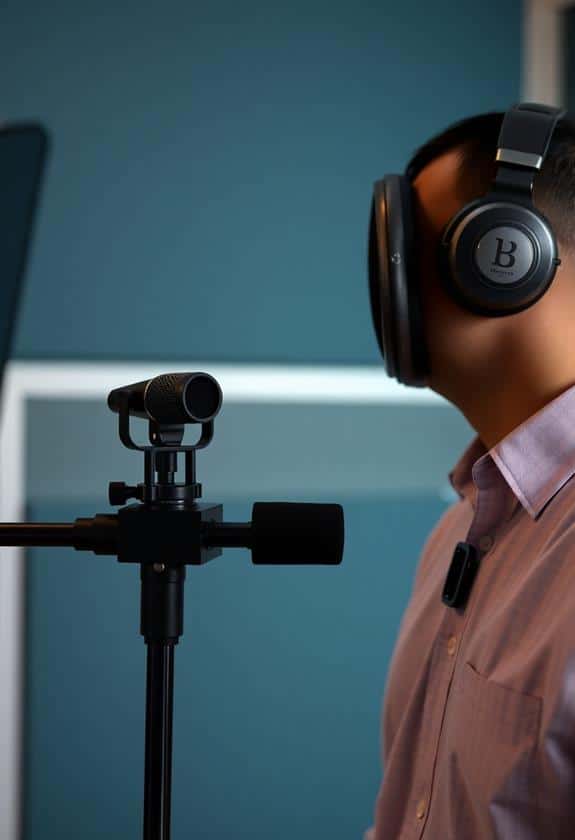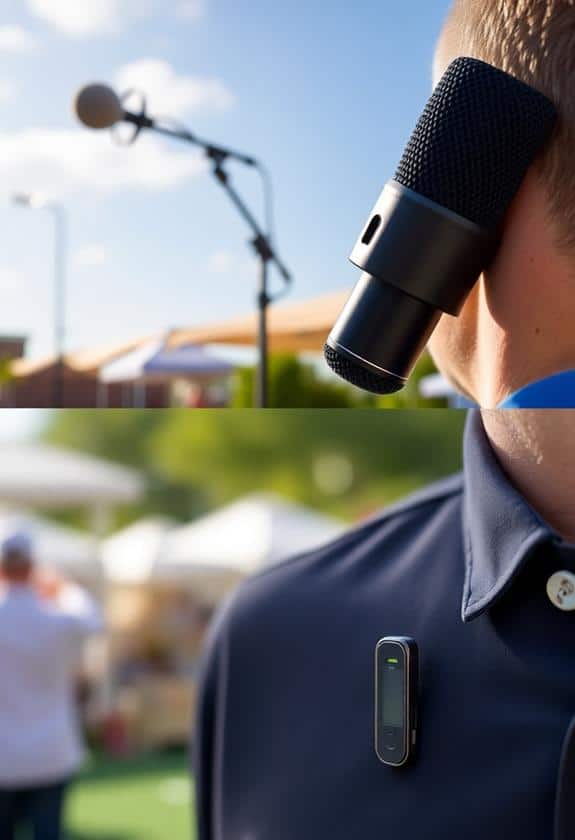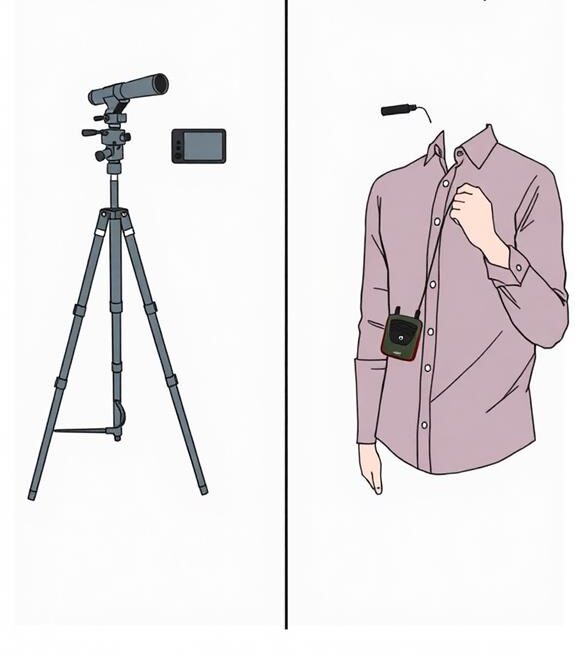When you’re choosing between a boom mic and a lavalier mic, think about how you want to capture sound. Boom mics, mounted on poles, catch audio from a distance and minimize background noise, perfect for busy scenes. On the other hand, lavalier mics are tiny and clip onto clothing, offering great mobility for interviews or dynamic shoots. However, they might pick up rustles and can be tricky to position. Your choice depends on the scene—you want clear, vibrant audio. Trust me, mastering mic use can transform your filmmaking experience, and there’s more to uncover about both types!
Key Highlights
- Boom mics are mounted on poles for distance sound capture, while lavalier mics are small and clip onto clothing for discreet use.
- Boom mics excel in dynamic environments, capturing dialogue without obstructing the frame; lavalier mics are ideal for close interviews and presentations.
- Boom mics require careful positioning and phantom power, while lavalier mics are more flexible, operating on batteries and needing secure attachment.
- Boom mics may capture unwanted background noise, whereas lavalier mics focus on the speaker’s voice, minimizing distractions with proper placement.
- Budget-wise, boom mics range from $150 to $1,000, while lavalier mics are generally more budget-friendly, ranging from $20 to $500.
Design and Form Factor

When it comes to design and form factor, boom mics and lavalier mics serve distinct purposes. You might think of boom mics as the long arms of the audio world. They’re mounted on a pole and can hover above your scene, picking up sound from a distance. This design lets you capture clear audio while keeping the mic out of the frame—perfect for those dramatic scenes. Additionally, boom mics like the Movo X3-II are designed to minimize background noise, ensuring high-quality sound capture. However, they can be a bit tricky to handle, especially if you’re filming in tight spaces.
On the other hand, lavalier mics, or lapel mics, are tiny and clip right onto your clothing. Imagine a little friend who’s always there, ready to catch every word you say! They’re super discreet, which is great for interviews or casual conversations. Just make sure they’re securely attached; you don’t want them falling off mid-sentence!
Both mics have their quirks, but they’re essential tools for any filmmaker. I remember once fumbling with a boom mic during a live shoot—it was a comedy of errors! Choose the right mic for your project, and you’ll not only enhance your audio but also keep everyone safe and sound.
Sound Capture Techniques

Choosing the right mic isn’t just about design; it also influences your sound capture techniques. When you’re out filming, the way you capture audio can make or break your project. A boom mic, for example, allows you to pick up sound from a distance, which means you can keep your subjects in a safe space while still getting clear audio. This is particularly important when using top microphones for filmmaking to guarantee you have the best quality sound. I remember a time when I was filming a scene in a busy park, and using a boom mic helped me avoid unwanted noise from nearby kids playing.
On the other hand, lavalier mics clip right onto your subjects, making them great for interviews or close-up shots. You might think they’re easier to manage, but they can pick up unwanted sounds too, like rustling clothes or even your subject’s breathing. I once forgot to check for those sounds during an interview, and it turned into a bit of a mess!
In both cases, it’s crucial to keep your mic away from potential hazards, like water or rough surfaces. So, whether you’re booming or lav-ing, remember: your sound capture techniques play a big role in creating something great!
Mobility and Flexibility

In the fast-paced world of filmmaking, mobility and flexibility are essential for capturing the best audio. Imagine you’re on set, trying to record a scene with actors moving around. This is where the differences between a boom mic and a lavalier mic become clear. A boom mic, held on a long pole, lets you reach your subjects without getting in the way. You can follow the action without tripping over cables, which is a safety win. With advanced noise cancellation technologies, boom mics can effectively reduce unwanted sounds, making them ideal for challenging environments with high audio quality.
On the other hand, lavalier mics, those tiny clip-on wonders, offer their own magic. They attach directly to the actors’ clothes, allowing them to move freely. This means you can capture their whispers and laughs, even when they’re running around. I remember a shoot where my boom mic nearly took out a light stand! It was a close call, reminding me how important it is to stay aware of my surroundings.
Both options give you flexibility, but you’ll need to choose based on the scene. Whichever you pick, remember that your safety—and that of your crew—is just as important as capturing great audio. So, be mindful, stay alert, and enjoy the creative journey!
Ideal Use Cases

Understanding the ideal use cases for boom mics and lavalier mics can greatly enhance your audio capture. Think about a film set where actors are moving around. A boom mic is fantastic for capturing dialogue without getting in the way. You can position it overhead, which keeps your scene clean and your actors safe. I remember one time, we were filming a chase scene, and having the boom mic helped us catch every thrilling word, while keeping it off-screen—a real relief! For more guidance on selecting the right equipment, consider checking out the best Lavalier mics.
On the other hand, lavalier mics are your best friends in interviews or presentations. They clip onto shirts, making them super discreet and perfect for capturing clear audio without all the fuss. I once used a lav mic during a school project, and it was so freeing! I could move around while still sounding professional.
Audio Quality Comparison

When it comes to audio quality, both boom mics and lavalier mics have their strengths and weaknesses. You’ll find boom mics are fantastic for capturing sound from a distance, which makes them perfect for capturing dialogue on set without being intrusive. I remember the first time I used one; I was amazed at how clear the sound was, even from several feet away. It felt like magic. In contrast, lavalier mics, known for their crystal clear audio quality, are those tiny clip-on wonders that are great for hands-free convenience. They pick up your voice up close, which can create a more intimate sound. I once filmed a scene where the actor had to walk around while talking, and the lavalier made it so easy to capture every word without any fuss.
However, keep in mind that lavalier mics can sometimes pick up extra noise if the actor moves too much, like clothing rustling. So, choosing the right mic often depends on your scene and what you’re trying to achieve. Whether you want that crisp distance or a snug conversation, knowing your mics can make all the difference in your audio quality adventure!
Background Noise Handling

Managing background noise is essential for achieving professional audio quality, and the choice between a boom mic and a lavalier mic can greatly impact this aspect. When I first started filming, I quickly learned that capturing clear sound is a game-changer. Boom mics tend to pick up sound from a distance, which means they can also catch unwanted background noise—think of that sneaky dog barking or kids playing nearby! If you’re in a bustling environment, it might not be your best friend.
On the other hand, lavalier mics are small and clip right onto your subject’s clothing. They focus on the speaker’s voice, making them fantastic for minimizing background noise. I remember using one during an interview, and it felt like magic—no distractions, just the person’s words coming through crystal clear.
However, keep in mind that lavalier mics can still pick up noise if they’re not placed correctly. So, positioning is key! Ultimately, knowing how each mic handles background noise can help you create safer, more polished projects. Your audience deserves to hear every word without distractions, and you deserve to feel proud of your work!
Setup and Installation

Setting up your audio equipment properly is essential for achieving the best sound quality, whether you’re using a boom mic or a lavalier mic. Trust me, I’ve had my fair share of audio mishaps on set, and a little prep goes a long way. When using a boom mic, make sure to position it about 2-3 feet above your subject, angling it down toward their mouth. This helps capture clear audio while minimizing background noise. Just be careful not to poke anyone in the eye—safety first!
On the other hand, for a lavalier mic, clip it securely to your subject’s shirt, about 6-8 inches from their chin. I once had a friend’s mic slip and dangle awkwardly, which made for some embarrassing moments in the final cut. So, double-check that it’s snug! Also, keep the cable tucked away to avoid tripping hazards.
Whether you’re on a fancy film set or just shooting with friends, taking a little extra time to set up your mics correctly can save you from a lot of headaches later. And hey, who doesn’t want to look like a pro?
Budget Considerations

Budgeting for audio equipment can feel overwhelming, but it’s essential for getting the best bang for your buck. When you’re diving into the world of filmmaking, you want to make sure you’re spending wisely, right? After all, you don’t want to break the bank and still end up with subpar audio quality.
Here’s a quick table to help you understand what you might expect to spend on boom mics and lavalier mics:
| Mic Type | Price Range | Quality Level |
|---|---|---|
| Boom Mic | $150 – $1,000 | Varies (often higher) |
| Lavalier Mic | $20 – $500 | Varies (budget-friendly) |
| Accessories | $10 – $300 | Necessary for both |
From my experience, I’ve found that mid-range options often strike the perfect balance between quality and cost. For instance, I once bought a $200 boom mic that transformed my audio quality! Remember, investing in good audio equipment not only enhances your film but also keeps your viewers safe from ear-splitting sounds. So, take your time, compare options, and don’t hesitate to ask for advice!
Power Requirements

When choosing between a boom mic and a lavalier mic, understanding their power requirements can greatly impact your shoot’s success. Boom mics often need phantom power, which means you’ll need to plug them into a mixing board or audio recorder that provides this power. This can feel a bit like juggling flaming torches—exciting, but you don’t want to drop anything!
On the other hand, lavalier mics usually run on batteries. While this gives you flexibility, it also means you should always check your battery before filming. I once started a scene only to discover my lav mic was dead, and let me tell you, the look on my actors’ faces was priceless—like they’d just bitten into a lemon!
Post-Production Editing

Once you’ve captured your audio, the next step is post-production editing, where you refine and polish your sound. This stage is essential because good audio can make or break your film. I remember my first project; I thought my recording was perfect, but once I started editing, I realized I had a lot of background noise. It was a bit overwhelming, but I learned so much!
When you edit, you’ll want to remove any unwanted sounds, like rustling or echo. Use software like Audacity or Adobe Audition—they’re user-friendly and have cool tools to clean up your audio. Don’t forget to check for volume levels, ensuring that your dialogue is clear and balanced. If a boom mic picks up some unwanted noise, you can often fix it with equalization or noise reduction filters.
Frequently Asked Questions
Can Boom Mics Be Used for Live Performances?
Absolutely, you can use boom mics for live performances! They’re great for capturing sound from a distance, like when performers are moving around. Just make sure the boom operator knows their stuff to avoid pesky background noise. I’ve seen it work wonders in theater settings, but it takes practice. Don’t forget to check the mic levels before the show; nobody wants to miss the punchline because of a technical hiccup!
Do Lavalier Mics Require Any Special Maintenance?
Lavalier mics don’t need much special maintenance, but you should take care of them. Make sure to keep the mic clean, especially after using it in sweaty situations, like during a performance. A gentle wipe with a cloth can do wonders! Also, check the battery regularly if it’s wireless. I once forgot, and it died mid-interview—talk about embarrassing! Just a bit of attention goes a long way in keeping your gear in top shape.
What Are the Best Brands for Boom Mics?
When it comes to boom mics, you’ll find some high-quality brands that really stand out. Rode and Sennheiser are favorites among filmmakers for their quality and reliability. If you want something budget-friendly, check out Audio-Technica; it delivers great sound without breaking the bank. Remember, investing in a good mic is like choosing a safety helmet—essential for protecting your audio adventures. Happy filming, and may your sound be crystal clear!
How Do Environmental Factors Affect Mic Performance?
Environmental factors can seriously impact your mic’s performance. If you’re filming outside, the wind can create unwanted noise, making it hard to hear dialogue. Rain? That’s a whole other challenge! You might want to contemplate windshields or protective covers. I once filmed in a park, and the rustling leaves nearly drowned out everything! So, always scout your location and plan ahead. It’s all about getting that clear sound without interruptions, right?
Can I Use Both Mics Simultaneously?
Did you know that using two microphones can enhance your audio quality by up to 50%? Absolutely, you can use both a boom mic and a Lavalier mic at the same time! Just make sure you monitor levels carefully to avoid any feedback or interference. I remember my first short film where I tried this—total game changer! Keep experimenting and have fun, but always prioritize safety when setting up your gear.
Conclusion
So, whether you’re using a boom mic or a lavalier, each has its perks and quirks. I remember a shoot where my lavalier got tangled in a tree—talk about a mic-acle! But honestly, picking the right mic can make all the difference in your film’s sound. So, think about your project’s needs, budget, and, of course, how much adventure you’re up for. Happy filming, and may your audio always be crystal clear!




